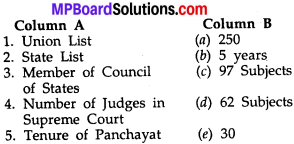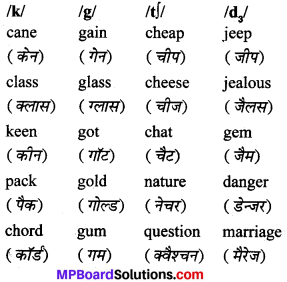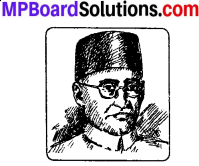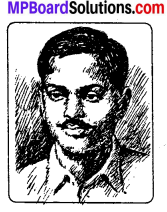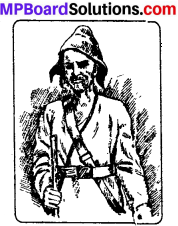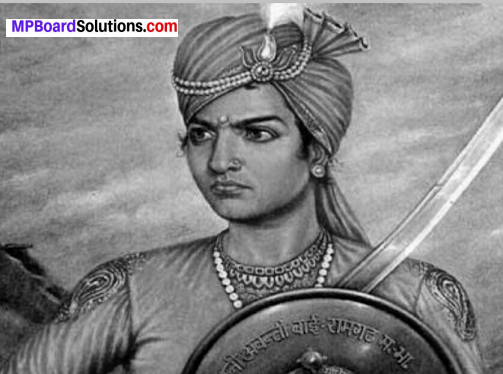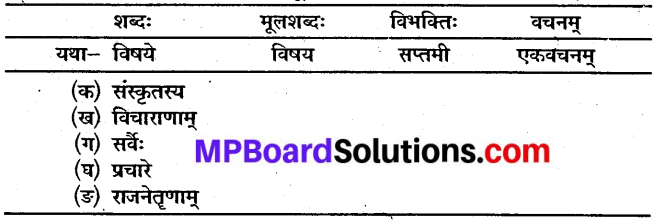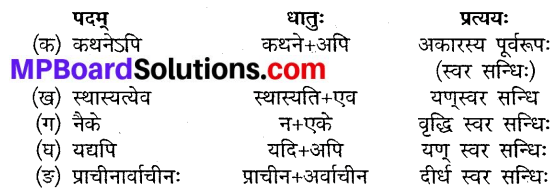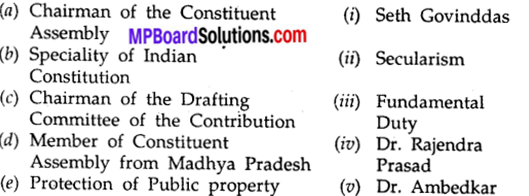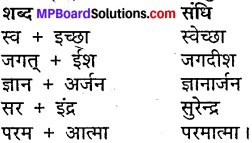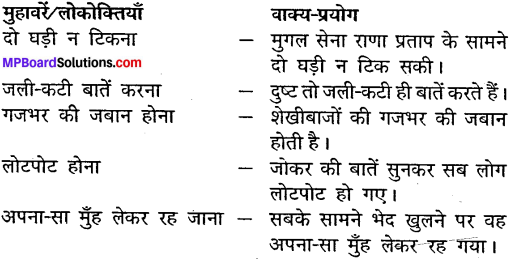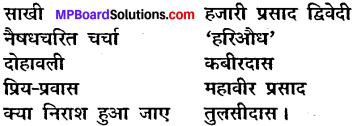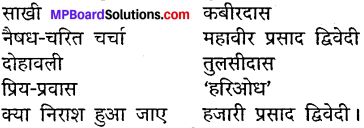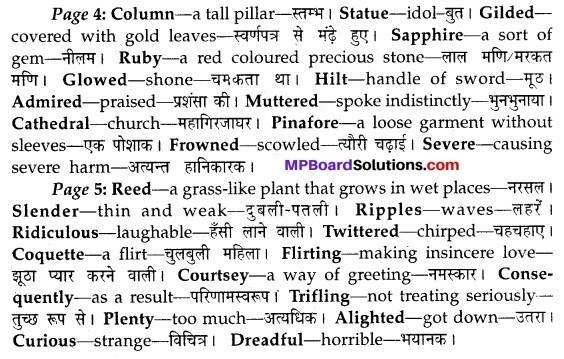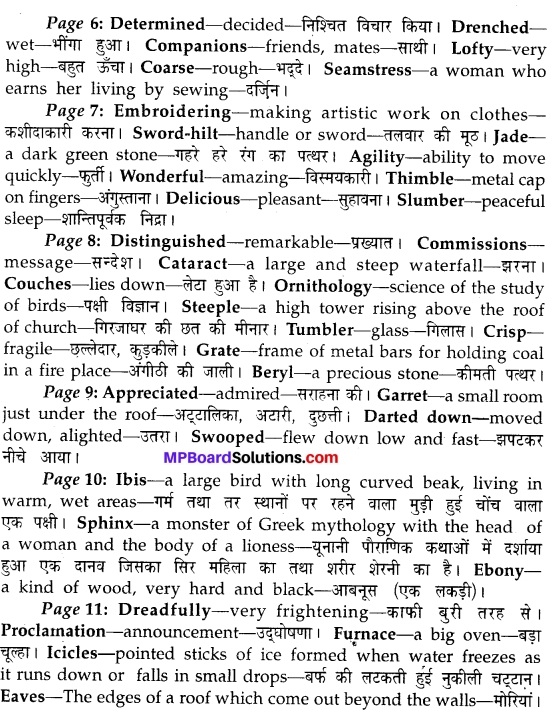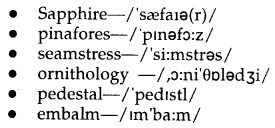MP Board Class 10th Sanskrit Solutions Durva Chapter 10 आह्वानम् (गीतम्) (सङ्कलितम्)
MP Board Class 10th Sanskrit Chapter 10 पाठ्यपुस्तक के प्रश्न
Mp Board Class 10 Sanskrit Chapter 10 प्रश्न 1.
एकपदेन उत्तरं लिखत-(एक पद में उत्तर लिखिए)।
(क) भारतस्य पुरातनः सखा कः विद्यते? (भारत का पुराना मित्र कौन है?)
उत्तर:
चीनः (चीन)
(ख) कस्मिन् प्रवर्तितुं कदापि न खिद्यते? (किसमें प्रवृत्त होने के लिए दुख नहीं होता?)
उत्तर:
स्वकर्मणि (अपने कर्म में)
(ग) पापसिन्धवः शत्रवः का प्रयान्तु? (पापरूपी समुद्र/शत्रु किसको प्राप्त हो?)
उत्तर:
अशेषताम् (समाप्ति को)
(घ) वयं कया स्वदेशरक्षणोद्यताः? (हम किससे अपने देश की रक्षा के लिए तैयार हों?)
उत्तर:
सत्यनिष्ठया (सत्य निष्ठा से)
(ङ) भारतीयकेतवः कां वृत्तिं स्फुरन्तु? (भारतीय झण्डे किस वृत्ति को स्फुरित करें?)
उत्तर:
अरातिनीवृतिम् (शत्रु को सब ओर से पकड़कर मारने के भाव को)
कक्षा 10 संस्कृत पाठ 10 MP Board प्रश्न 2.
एकवाक्येन उत्तर लिखत-(एक वाक्य में उत्तर लिखिए-)
(क) कृषीबलैः काः समेधिताः भवन्तु? (किसानों के द्वारा वया वृद्धि को प्राप्त हो?
उत्तर:
कृषीबलैः धान्यवृद्धयः समेधिताः भवन्तु। (किसानों के द्वारा धानअदि वृद्धि को प्राप्त हों।)
(ख) ऊर्जितं यशः कैः अर्जितम्? (तेजस्वितापूर्ण यश किसके द्वारा अर्जित किया गया?)
उत्तर:
ऊर्जितं यशः पूर्वपुरुषैः अर्जितम्। (तेजस्वितापूर्ण यश पूर्वजों द्वारा अर्जित किया गया।)
(ग) अखर्वगर्ववृत्तिना केन वीक्षितम्? (बड़े घमण्डी आचरण वाले किराको देखा गया?)
उत्तर:
अखर्वगर्ववृत्तिना अरिणा वीक्षितम्।
(बड़े धमण्डी आचरण वाले शत्रु के द्वारा देखा गया।)
(घ) भारतीयाः केषां वंशजाः सन्ति? (भारतीय किसके वंशज हैं?)
उत्तर:
भारतीयाः वसिष्ठ-याज्ञवल्क्य-गौतम-अत्रि एतेषाम् वंशजाः सन्ति। (भारतीय वसिष्ठ-याज्ञवल्क्य-गौतम व अत्रि के वंशज हैं।)
(ङ) शत्रवः द्रुतं किं फलं प्राप्नुवन्तु? (शत्रु शीघ्र किस फल को प्राप्त हों?)
उत्तर:
शत्रवः द्रुतं निजप्रवञ्चनाफलं प्राप्नुवन्तु। (शत्रु शीघ्र अपने उगी रूपी कर्म के फल को प्राप्त हों।)
Class 10 Sanskrit Chapter 10 MP Board प्रश्न 3.
अधोलिखितप्रश्नानाम् उत्तराणि लिखत-(नीचे लिखे प्रश्नों के उत्तर लिखिए)
(क) वीरबन्धवः किं कुर्वन्तु? (वीर बन्धु क्या करें?)
उत्तर:
वीरबन्धवः पापसिन्धवः शत्रवः अशेषतां प्रयान्तु।। (वीरबन्धु पाप रूपी समुद्र जैसे शत्रुओं को समाप्त करें।)
(ख) अद्य कं स्मरन्तु? (आज किसको याद करें?)
उत्तर:
अद्य पूर्वपुरुषैः समस्तदिक्षुविश्रुतं अर्जितम् ऊर्जितम् यशः स्मरन्तु। (आज पूर्वजों के द्वारा, सारी दिशाओं में विख्यात, अर्जित तेजस्वीपूर्ण यश को स्मरण करें।)
(ग) भवत्सु जीवितेषु के नदन्ति? (आप सब में जीवित रहते हुए कौन अस्पष्ट बोल रहे हैं?)
उत्तर:
भवत्सु जीवितेषु दस्यवः नदन्ति। (आप सब में जीवित रहते हुए लुटेरे अस्पष्ट बोल रहे हैं।)
Sanskrit Class 10 Chapter 10 Mp Board प्रश्न 4.
उचितशब्देन रिक्तस्थानानि पूरयत (उचित शब्दों से रिक्त स्थान भरिए-)
(क) स्वकर्मणि प्रवर्तितुं ………………. नैव खिद्यते। (अद्यापि/कदापि)
(ख) पुरातनं स्वपौरुष ………………. वीरबन्धवः। (विस्मरन्तु/स्मरन्तु)
(ग) यथा विहाय ………………. आचरन्तु तेऽद्भुतम् ।(कूटनीतिम्/राजनीतिम्)
(घ) समस्तदिक्षु ………………. तदद्य यावदूर्जितम्। (श्रुतं/विश्रुत)
(ङ) कदा प्रदर्शयिष्यते द्विषां ………………. बलस्य वः। (बलं/फल)
उत्तर:
(क) कदापि
(ख) स्मरन्तु
(ग) कूटनीतिम्
(घ) विश्रुतं
(ङ) फलं
Class 10th Sanskrit Chapter 10 प्रश्न 5.
यथायोग्यं योजयत-(उचित क्रम से जोड़िए)

उत्तर:
(क) 2
(ख) 1
(ग) 4
(घ) 5
(ङ) 3
Mp Board Class 10th Sanskrit Chapter 10 प्रश्न 6.
अधोलिखितपदानां मूलशब्दं विभक्तिं वचनञ्च लिखत (नीचे लिखे पदों के मूलशब्द विभक्ति और वचन लिखिए)

उत्तर:

Chapter 10 Sanskrit Class 10 MP Board प्रश्न 7.
अघोलिखितक्रियापदानां धातुं लकारं पुरुषं वचनञ्च लिखत (नीचे लिखे क्रियापदों के धातु, लकार, पुरुष व वचन लिखिए-)

उत्तर:

Sanskrit Chapter 10 Class 10 Mp Board प्रश्न 8.
विलोमशब्दान् लिखत-(विलोम शब्द लिखिए)
यथा – स्वदेशः – विदेशः
(क) स्मरन्तु
(ख) पुरातनम्
(ग) अशेषताम्
(घ) सत्यनिष्ठया
उत्तर:
(क) स्मरन्तु – विस्मरन्तु
(ख) पुरातनम् – नवीनम्
(ग) अशेषताम् – शेषताम्
(घ) सत्यनिष्ठया – असत्यनिष्ठया
Class 10 Sanskrit Chapter 10 Solutions MP Board प्रश्न 9.
पर्यायशब्दान् लिखत-(पर्यायशब्द लिखिए)
यथा – सूर्य दिवाकरः, भास्करः
(क) कालः
(ख) क्षितौ
(ग) शत्रवः
(घ) जगत्सु
उत्तर:
(क) कालः – समयः
(ख) क्षितौ – पृथिव्याम्, धरायाम्
(ग) शत्रवः – रिपवः, अरयः
(घ) जगत्सु – संसारेषु, विश्वेषु
Class 10 Sanskrit Chapter 10 Question Answer MP Board प्रश्न 10.
रेखाङ्कितपदान्याधृत्य प्रश्ननिर्माणं कुरुत (रखाङ्कित पदों के आधार पर प्रश्न बनाइए)
(क) दस्यवः नदन्ति
(लुटेरे अस्पष्ट बोल रहे हैं।)
उत्तर:
के नदन्ति? (कौन अस्पष्ट बोल रहे हैं?)
(ख) वयं हिमालयस्य रक्षणे समुद्यताः। (हम सब हिमालय की रक्षा के लिए तैयार हों।)
उत्तर:
वयं कस्य रक्षणे समुद्यताः? (हम किसकी रक्षा के लिए तैयार हों?)
(ग) पापसिन्धवः शत्रवः अशेषतां प्रयान्तु। (पाप रूपी समुद्र शत्रु समाप्ति को प्राप्त हों।)
उत्तर:
के शत्रवः अशेषतां प्रयान्तु? (कौन से शत्रु समाप्ति को प्राप्त हों?)
(घ) ते कूटनीतिं विहाय आचरन्तु। (वे कुटनीति को छोड़कर आचरण करें।)
उत्तर:
ते किं विहाय आचरन्तु? (वे किसको छोड़कर आचरण करें?)
(ङ) नदीषु यन्त्रयानलौहमार्गसेतवः सन्तु। (नदियों पर मशीनों द्वारा चलने वाले वाहन, लोहे की पटरी वाले रास्ते तथा पुल हों।)
उत्तर:
केषु यन्त्रयान लौह मार्ग सेतवः सन्तु?
(किन पर मशीनों द्वारा चलने वाले वाहन, लौहे की पटरी वाले रास्ते तथा पुल हों।)
योग्यताविस्तार –
पाठे आगतं गीतं लयबद्धं गायत।
(पाठ में आए गीत को लयबद्ध करके गाओ।)
अन्यदेशभक्तिविषयकं संस्कृतगीतम् अन्विष्य गायत।
(अन्य देश भक्ति के संस्कृत गीत ढूंट कर गाओ।)
आह्वानम् पाठ का सार
प्रस्तुत पाठ एक गीत है जो श्री दयाशङ्कर वाजपेयी के द्वारा रचा गया है, जिसमें भारत और चीन के मध्य हुए युद्ध में भाग लेने वाले सैनिकों के साथ प्रत्यक्ष चर्चा करके लिखा गया है।
आह्वानम् पाठ का अनुवाद
1. युवान एष वः परीक्षणस्य काल आगतः हिमालयस्य रक्षणे समुद्यताः स्थ सर्वतः।
अयं सखा पुरातनोऽस्य भातरस्य विद्यते स्वकर्मणि प्रवर्तितुं कदापि नैव खिद्यते॥1॥
अन्वयः :
युवान! एषः कालः वः परीक्षणस्य आगतः (अस्ति), सर्वतः, हिमालयस्य रक्षणे समुद्यताः स्थ। अयम् अस्य भारतस्थ पुरातनः सखा विद्यते स्वकर्मणि प्रवर्तितुं कदापि न एव खिद्यते।
शब्दार्थाः :
युवान!-हे युवको!-oh young men; वः-तुम्हारा-yours; समुद्यताःतैयार-ready; स्थ-हों-be; खिद्यते-दुखी होता है-is aggrieved.
अनुवाद :
हे युवको! यह समय तुम्हारी परीक्षा का है, सब ओर से हिमालय की रक्षा के लिए तैयार हो। यह इस भारत का पुराना मित्र है। अपने कर्म में प्रवृत्त होने के लिए कभी भी दुखी नहीं होता है।
English :
Young men, be ready to defend Himalaya-India’s oldest friend never aggrieved in getting inclined to self duties.
2. अखर्वगर्ववृत्तिनारिणात्र येन वीक्षितं सहेक्षणेन तत्क्षणन्तु तच्छिरः क्षितौ धृतम्।
यथा क्षमावशा वयं तथैव रोषपूरिताः यथैव शीलसंस्कृतास्तथा प्रसिद्धशूरताः॥2॥
अन्वयः :
अत्र येन अखर्वगर्ववृत्तिना अरिणा वीक्षितम् (तदा) तत् क्षणं तु ईक्षणेन सह तच्छिरः क्षितौ धृतम्, वयं यथा क्षमावशाः (स्मः) तथैव वयं रोषपूरिता (अपि स्मः), (एवमेव) यथा शील-संस्कृता एव तथा प्रसिद्धशूरताः (स्मः)।
शब्दार्थाः :
अखर्वगर्ववृत्तिना-बड़े घमण्डी आचरण वाले के द्वारा-of proud conduct (arrogant);अरिणा-शत्रु के द्वारा-by enemy; वीक्षितम्-देखा गया-seen; सहेक्षणेन-देखने के साथ ही-at the very sight; धृतम्-रख दिया-placed.
अनुवाद :
यहाँ जिस, बड़े घमण्डी आचरण वाले शत्रु के द्वारा देखा गया, तब उस क्षण तो देखने के साथ ही पृथ्वी पर गिरा दिया, हम जितने क्षमाशील हैं, उतने ही क्रोध से भरे हुए भी हैं। इस प्रकार जैसे हमारी शील संस्कृति प्रसिद्ध है वैसे ही वीरता भी।
English :
We beheaded the proud enemy for his evil intentions-We are both forgiving and equally brave.
3.पुरातनं स्वपौरुषं स्मरन्तु वीरबन्धवः अशेषतां प्रयान्तु शत्रवोऽद्य पापसिन्धव। – निजप्रवञ्चनाफलं समाप्नुवन्तु ते द्रुतं यथा विहाय कूटनीतिमाचरन्तु तेऽद्भुतम्॥3॥
अन्वयः :
वीरबन्धवः! पुरातनं स्वपौरुषं स्मरन्तु अद्य पापसिन्धवः शत्रवः अशेषतां प्रयान्तु। ते द्रुतं निजप्रवञ्चनाफलं समाप्नुवन्तु, यथा ते अद्भुतं कूटनीतिं विहाय आचरन्तु।।
शब्दार्थाः :
स्वपौरुषम्-अपने पुरुषत्व को-own valour; पापसिन्धवः-पापरूपी समुद्र-ocean in the form of sin; अशेषताम्-समाप्ति का-completion; निजप्रवञ्चनाफलम्-अपने ठगी रूपी कर्म के फल को-fruitof their trickery;समाप्नुवन्तु-प्राप्त करें-obtain; विहाय-छोड़कर-leaving.
अनुवाद :
हे वीर बन्धुओ! अपने पुराने पुरुषत्व को याद करो, आज पापरूपी समुद्र से शत्रु समाप्ति को प्राप्त हो। वे शीघ्र अपने ठगी रूपी कर्म के फल को प्राप्त करें, जिससे वे अपनी अजीब सी कूटनीति को छोड़कर अच्छा आचरण करें।
English :
Remember your chivalry-Bring an end to sinful enemies-tell them suffer the fruit of their trickery and leave diplomacy.
4. कृषीबलैः समेधिता भवन्तु धान्यवृद्धयः श्रमेण सन्तु साधितास्तु वीरसाहसर्द्धयः।
स्मरन्तु पूर्वपूरुषैर्जगत्सु यद् यशोऽर्जितम् समस्तदिक्षु विश्रुतं तदद्य यावदूर्जितम्॥4॥
अन्वयः :
कृषीबलैः धान्यवृद्धयः समेधिताः भवन्तु श्रमेण साधिताः तु वीरसहासर्द्धयः सन्तु। पूर्वपुरुषैः जगत्सु, समस्तदिक्षुविश्रुतं यावद् ऊर्जितं यशः अर्जितं, तद् अद्य स्मरन्तु।
शब्दार्थाः :
कृषीवलैः-किसानों के द्वारा-By farmers; समेधिताः-वृद्धि को प्राप्त-attain propserity; वीरसाहसर्द्धय-पराक्रम-उत्साह की वृद्धि-increase invalour and courage; दिक्षु-दिशाओं में-indirections; विश्रुतम्-विख्यात-famous; अर्जितम्-तेजस्विता पूर्ण-full of bu’stre; स्मरन्तु-स्मरण करें-remember.
अनुवाद :
किसानों के द्वारा धान्य-वृद्धि से वृद्धि को प्राप्त हो, परिश्रम से प्राप्त । पराक्रम व उत्साह की वृद्धि हो। संसार में पूर्वजों के द्वारा समस्त दिशाओं में विख्यात, जो तेजस्वितापूर्ण यश प्राप्त किया है, उसे आज याद करो।
English :
Let farmers flourish-let there be advancement in courage-remember the renown of your ancestors through the world.
5. वयं तु सत्यनिष्ठया स्वदेशरक्षणोधताः प्रवञ्चनैकदक्षशत्रुपक्षतक्षणव्रताः।
नदीषु सन्तु यन्त्रयानलौहमार्गसेतवः अरातिनीवृतिं स्फुरन्तु भारतीयकेतवः॥5॥
अन्वयः :
वयं तु सत्यनिष्ठया स्वदेशरक्षणोद्यताः प्रवञ्चनैकदक्षशत्रुपक्षतक्षणव्रताः (स्मः), नदीषु यन्त्रयानलौहमार्गसेतवः भारतीय केतवः अरातिनीवृत्तिं स्फुरन्तु।
शब्दार्थाः :
सत्यनिष्ठया-सत्यनिष्ठा से-with sincere loyalty; उद्यताः-तैयार -ready; केतवः-झण्डे-flags; अरातिनीवृत्तिम्-शत्रु को सब ओर से पकड़कर मारने के भाव को-enemies by grabbing them all over.
अनुवाद :
हम सब तो सत्यनिष्ठा से अपने देश की रक्षा के लिए तैयार हैं, एकमात्र छल-कपट में निपुण शत्रुओं के पक्ष को काटने का वृत धारण करने वाले हैं, नदियों पर मशीनों द्वारा चलने वाले वाहन, लोहे की पटरी वाले रास्ते तथा पुल हों, भारतीय पताकाएँ शत्रु को सब ओर से पकड़कर मारने के भाव को स्फुरित करें।
English :
We are ready to serve our country honestly. We will sever the heads of deceitful enemies-let there be machines and iron rails. Let the Indian flags be unfurled around the enemies.
6. अये वशिष्ठ-याज्ञवल्क्य-गौतमात्रिवंशजाः तथैव सूर्यचन्द्रपावकान्ववायतल्लजाः। – भवत्सु जीवितेषु हन्त! किं नदन्ति दस्यवः? कदा प्रदर्शयिष्यते द्विषां फलं बलस्य वः॥6॥
अन्वयः :
हन्त! अये वसिष्ठ-याज्ञवल्क्य-गौतम-अत्रि वंशजा (सन्ति), तथैव सूर्यचन्द्रपावकान्ववायतल्लजाः भवत्सु जीवितेषु दस्यवः किंनदन्ति? वः बलस्य फलं द्विषां (कृते) कदा प्रदर्शयिष्यते।
शब्दार्थाः :
हन्त!-खेद है-Alas! fie; अन्ववायतल्लजाः-कुल में सर्वश्रेष्ठ-of noblest family; भवत्सु-आप सब में-in you all; जीवितेषु-जीवित रहते हुए-while living; दस्यवः-लुटेरे-robbers; नदन्ति-अस्पष्ट बोल रहे हैं -speaking vaguely; वः-तुम्हारे-yours; द्विषाभ्-शत्रुओं के-of enemies.
अनुवाद :
खेद है। अरे, वसिष्ठ, याज्ञवल्क्य, गौतम अत्रि के वंश में आप उत्पन्न हुए हैं। वैसे ही, सूर्य और चन्द्र से पवित्र, कुल में सर्वश्रेष्ठ आप सब के जीवित रहते हुए लुटेरे अस्पष्ट बोल रहे हैं। तुम्हारे बल का फल शत्रुओं को कब दिखाओगे।
English :
You are the descendants of rishis and of noble birth show your valour to let down robberr.

